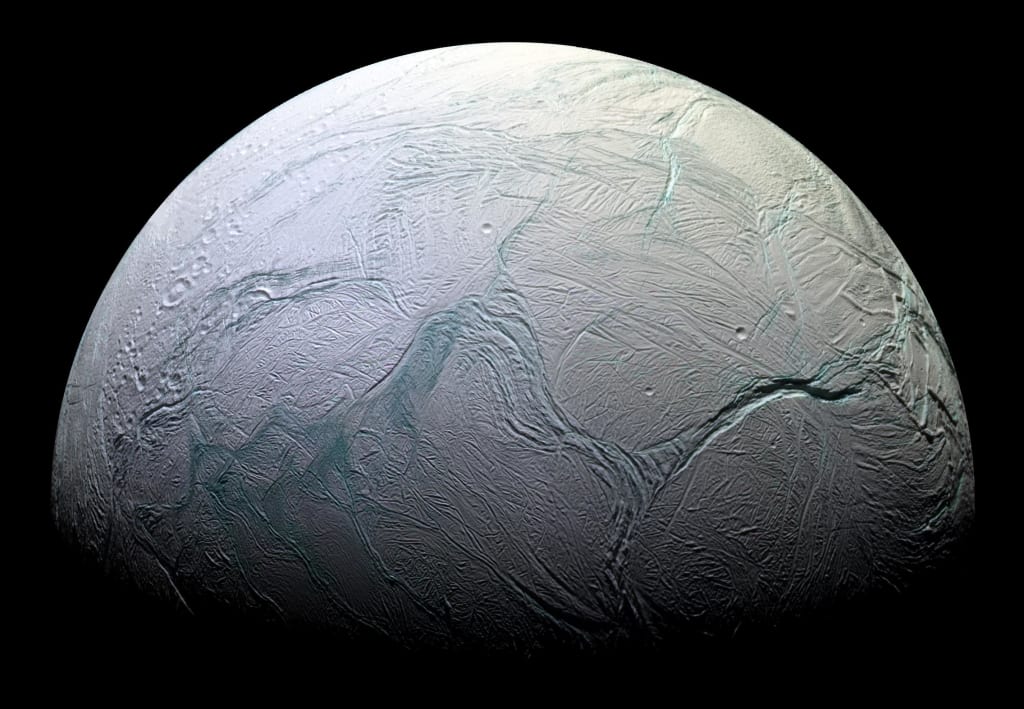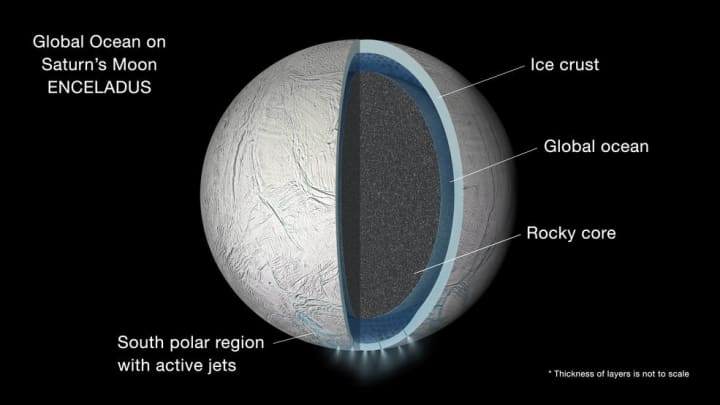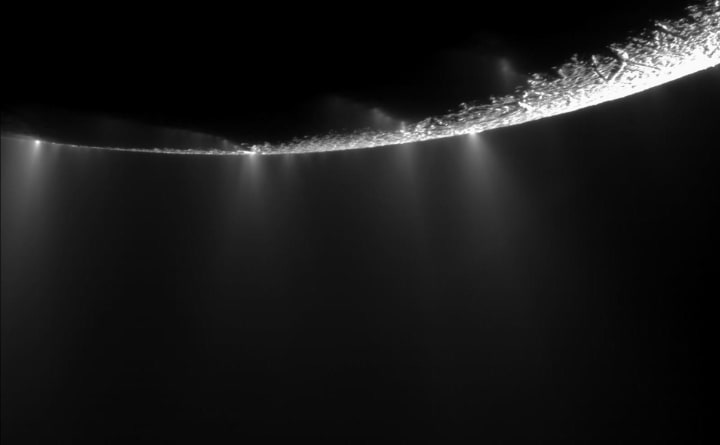Enceladus' Ice-Covered Ocean Closer to Surface Than Previously Thought
Warmer temperatures than expected in ice fissures also boost potential for alien life.

When it comes to places in the Solar System to search for possible alien life, Saturn's moon Enceladus is now right near the top of the list. Like Jupiter's moon Europa, it has a subsurface ocean of water, and even plumes/geysers of water vapor which erupt from fissures in the icy surface near the south pole. Those plumes contain organics as discovered by the Cassini probe and there is evidence for hydrothermal activity on the ocean floor, just like on Earth. The fissures are warmed by heat from below, and now there is evidence that some of them are even warmer than expected, meaning that water could be closer to the surface than previously thought.
The new study was just published in the journal Nature and shows that the icy surface is warmer than thought just a few feet down.
"Finding temperatures near these three inactive fractures that are unexpectedly higher than those outside them adds to the intrigue of Enceladus," said Cassini Project Scientist Linda Spilker at NASA's Jet Propulsion Laboratory in Pasadena, California. "What is the warm underground ocean really like and could life have evolved there? These questions remain to be answered by future missions to this ocean world."
The new findings are in agreement with a separate study from 2016 which estimated an average thickness for the ice shell of 11-14 miles (18-22 kilometers), with a thickness of less than 3 miles (5 kilometers) at the south pole, where the fissures are located.
Tiger stripe fissures at Enceladus' south pole

The tiger stripes at Enceladus' south pole. The colored region is the area targeted by the new study. Image by NASA/JPL-Caltech/Space Science Institute
Three fissures in particular show the excess heat, which are similar to the larger "tiger stripes" fissures close by, which are the fissures that the plumes currently originate from. These three fissures don't have active plumes right now, but they are warmer, just like the other tiger stripes. This could be evidence for various episodes of activity in the past, in different locations on the moon's surface.
"The thermal anomaly we see at microwave wavelengths is especially pronounced over three fractures that are not unlike the tiger stripes, except that they don't seem to be the source of jets at the moment," said Alice Le Gall from Laboratoire Atmosphères, Milieux, Observations Spatiales (LATMOS), and Université Versailles Saint-Quentin (UVSQ), France. Alice is also an associate member of the Cassini RADAR instrument team and the lead scientist of the new study.
The new study is based on data collected by Cassini during a fly-by of Enceladus in 2011.
"During this flyby, we obtained the first and, unfortunately, only high-resolution observations of Enceladus' south pole at microwave wavelengths," said Alice.
Interior of Enceladus

Graphic depicting the interior of Enceladus. Image by NASA/JPL-Caltech
"These observations provide a unique insight into what is going on beneath the surface. They show that the first few metres below the surface of the area that we investigated, although at a glacial 50-60 K, are much warmer than we had expected: likely up to 20 K warmer in some places," she added.
"This cannot be explained only as a result of the Sun's illumination and, to a lesser extent, Saturn’s heating so there must be an additional source of heat."
Apparently, the heat detected is lying beneath a layer of frost, since it was not seen in infrared observation of the same region, which only looks at the top surface, not what is below.
The observations cover a narrow, arc-shaped band in the southern polar region, about 310 miles (500 kilometers) long and 16 miles (25 kilometers) wide, and located just 17 miles (30 kilometers) to 31 miles (50 kilometers) north of the tiger-stripe fractures. Due to operational constraints of the 2011 flyby, it was not possible to obtain microwave observations of the active fractures themselves. That turned out to be a good thing actually, as it allowed scientists to observe that the thermally anomalous terrains of Enceladus extend well beyond the main tiger stripes.
The geysers of Enceladus

The water vapor plumes on Enceladus, erupting from fissures at the south pole. Image by NASA/JPL-Caltech/Space Science Institute
The scientists also said that even though the observations cover a small area, it is likely that the entire region is warm, and the ocean may be as little as 2 kilometers below the surface. This is much less than Europa's ocean, which is thought to be at least several miles below the surface. It would also make it easier to drill down through the ice on a future mission, to sample the water itself.
"This discovery opens new perspectives to investigate the emergence of habitable conditions on the icy moons of the gas-giant planets," said Nicolas Altobelli, ESA's Project Scientist for Cassini–Huygens.
"If Enceladus' underground sea is really as close to the surface as this study indicates, then a future mission to this moon carrying an ice-penetrating radar sounding instrument might be able to detect it."
Since other observations by Cassini have found evidence for hydrothermal activity on the ocean floor, which enable oasis of life to exist deep in Earth's oceans, scientists now think that Enceladus' ocean could well support some kind of life as well, at least microbial. The plumes contain water vapor, ice crystals, salts and organics of varying complexity. Cassini can't detect life itself, but potential follow-up missions would be able to.
Enceladus presents a unique opportunity for planetary scientists to be able to study an alien ocean and better understand whether such subsurface environments could be not only habitable, but actually home to some form of life.
About the Creator
Paul Scott Anderson
Paul is a freelance space writer and blogger who currently writes for AmericaSpace and Vocal. His own blog Planetaria is a chronicle of planetary exploration.
paulscottanderson.ca
planetaria.ca






Comments
There are no comments for this story
Be the first to respond and start the conversation.